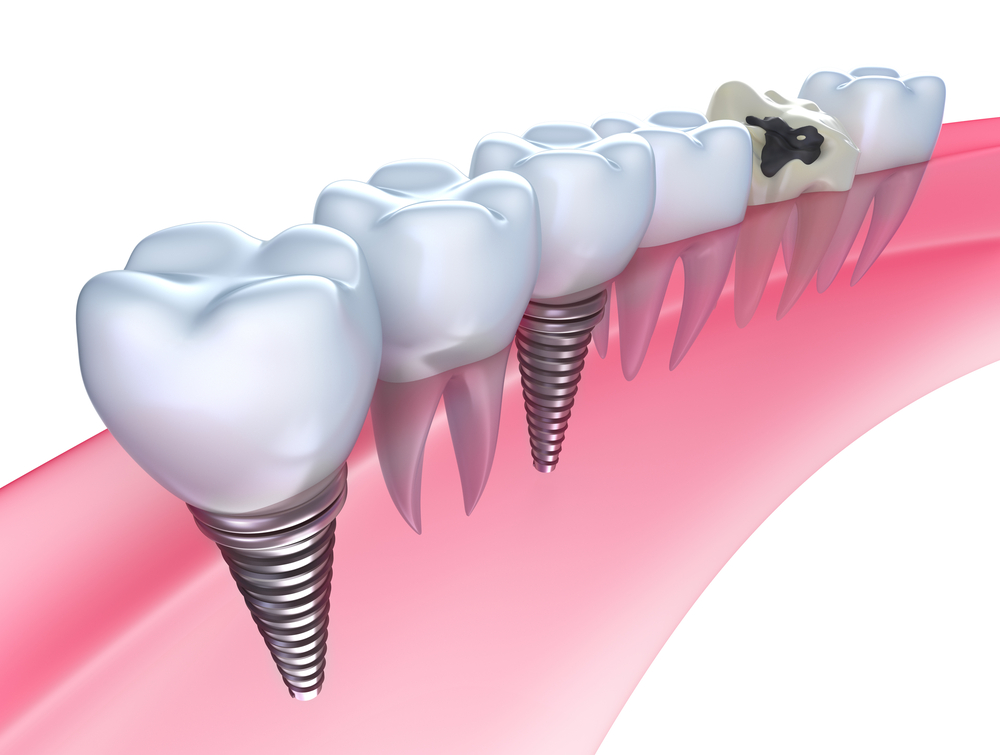What Are The Three Types of Dental Implants
Dental implants are one of the most common cosmetic dentistry procedures and are used to correct aesthetic and functional dental problems for those who are tired of ill fitting dentures or have missing teeth. Implants create a natural, beautiful smile through a multi-step surgical procedure in which custom-made, artificial teeth are fused in your jawbone. These fuses work as “anchors” or roots for artificial teeth.
Are There Different Types of Implants?
When it comes to dental implants patients have the option to choose from three different types. Unsure which may be best? Part of the dental implant process includes an evaluation before the implant portion ever takes place. Your cosmetic dentist can help determine which is best for your unique situation.

Endosteal Implants
Endosteal implants are perhaps the most common implant type. These implants are usually made of titanium and are screwed into the jawbone, protuding through the gum to hold the replacement tooth, or teeth, in place. They usually work well for most patients, but require candidates to have a strong, healthy jawbone. Those with osteoperosis or other bone issues will likely not be good candidates for this implant type.
The ideal patients to receive this type of implant:
- Are in overall strong health
- Have good oral health and don’t have periodontal disease
- Have fully developed jaw bones
- Are not capable of wearing dentures
Subperiosteal Implants
For those who have bone issues or whose jawbone is not healthy enough to support an endosteal implant may be considered for subperiosteal implants. Subperiosteal implants are made from titanium alloy, and unlike the endosteal implants are anchored on or above the jawbone using a metal frame instead of being drilled into the jawbone itself. The frame is made with a series of posts that support the prosthetic teeth, much like a crown or denture.
The ideal patients to receive this type of implant:
- Lack enough bone structure for endosteal implants
- Have shallow jawbones or suffer from thyroid issues, calcium defiency or age-related complications
- Only need their back teeth replaced (this implant type is not suitable for front teeth replacement)
Zygomatic Implants
Zygomatic dental implants are perhaps the least commmon implant type and are made specifically for those with severe bone loss. These implants are designed with a much longer, angled screw which are placed into a patient’s cheekbone, or the zygoma. The cheekbone is a dense structure and provides a long-lasting support for the implant. With this procedure, no bone grafting is required and can be used in conjunction with other implant types, but some patients have reported an onset of sinustis as a result of the implant.
The ideal patients to receive this type of implant:
- Lack enough bone structure for endosteal implants
- Have shallow jawbones or suffer from thyroid issues, calcium defiency or age-related complications
- Only need their back teeth replaced (this implant type is not suitable for front teeth replacement)
The ideal patients to receive this type of implant:
- Have severe bone loss
- Experience difficulty with dentures are unable to eat, chew, or speak adequately as a result
- Have a doctor referral and have exhausted all other options.
Step 1. Evaluation. Before the surgeries can begin you must undergo a thorough analysis of your current condition. This requires:
- A comprehensive oral exam
- Medical history review
- Personalized treatment plan
Step 2. Inserting the implants. Depending on the implant type, and your bone health, before the implants are inserted you may need a bone graft to help support the strength of the jaw bone. Once the bone graft has attached strongly enough and your dentist has confirmed it can support the next phase of the process, you’re ready for the implant stage! Your surgeon will open your gums to expose the bone and drill small holes into the bone. These holes are where the metal implant posts will be inserted.
Step 3. Bone growth. From there it’s a bit of a waiting game. The jawbone must grow into the surface of the dental implant, which can also take several months… but this is not a phase to be rushed! Without a solid base, your new teeth will not have enough support.
Step 4. Abutment. This is a minor, outpatient surgery which ensures there’s a place where the crown of your new teeth will be attached.
Step 5. Molding artificial teeth. When your gums have healed your dentist will make new molds to shape natural looking teeth which will be attached to your crowns. Of course, your jaw must be healed and strong enough to support the new teeth, but from there you’ll be well on your way to a fresh set of teeth.

About Us
Located in San Diego, CA, the Art of Dentistry dentists are consistently recognized as top in their field by their peers. The Art of Dentistry prides itself on our highly experienced and skilled staff. We understand that, just like other artists, each specialist has their own unique talents. To take full advantage of that, we have developed a team of top specialists to work collaboratively and provide you with comprehensive care that results in a magnificent smile. We offer target skill sets, advanced technology, customized treatment plans, comprehensive restorative dentistry as well as general dentistry, and much more.
No comments:
Post a Comment